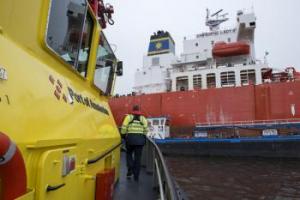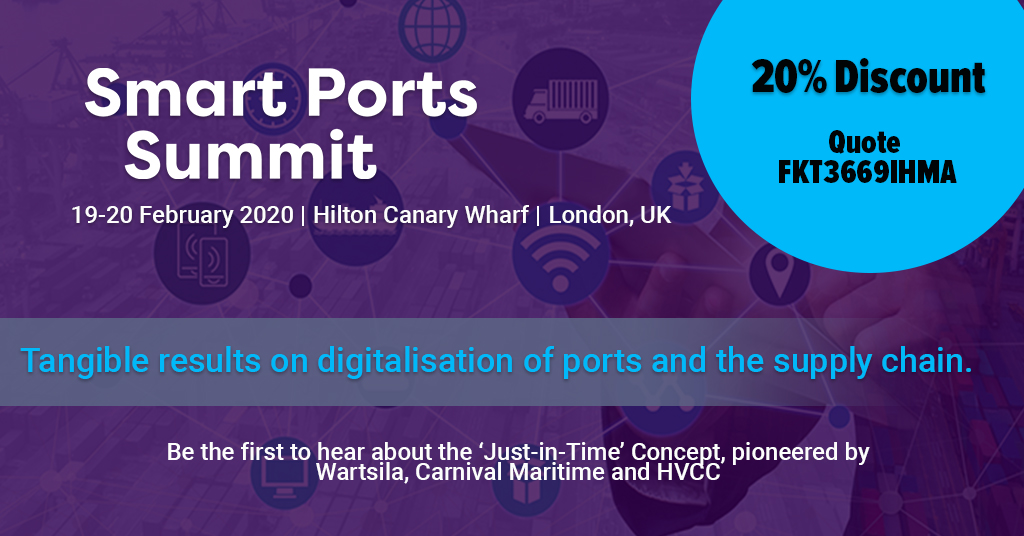Harbour Master
Harbour Masters
Worldwide there are approximately 3,000 merchant ports and the work of the Harbour Master can vary widely from country to country and from port to port even within the same country.


The Smart Ports Summit, 19-20 February 2020, brings together the experts and innovators who are addressing the real need for optimatision of global supply chains and ports to secure fast and efficient movement of goods, manage mega vessels and meet sustainability targets.
Shippers have become increasingly frustrated with lack of visibility, communication, modern equipment and technology at port hubs. Problems often arise whereby a full logistics team is not ready to receive a vessel; leading to unnecessary delays with transporting goods to their final destination.
What can ports do to be more transparent for shippers?
To overcome these difficulties, ports and their supply chains are transforming into smart port ecosystems. Key to embracing this change is the adoption of data-sharing, transparency, collaboration, fast and well-connected software and corresponding cyber security protections.
Exclusive: Introducing the Just-in-Time Arrival Concept
The pioneers behind the Just om Time Concept at the Port of Hamburg have chosen the Smart Port Summit as the venue to announce their results. Created by Wärtsilä, HVCC Hamburg Vessel Coordination Center and Carnival Maritime - the findings from these innovative stakeholders will be presented for the first time at the Summit.
Join us at the Smart Ports Summit this February to find out how the marine industry is adapting to customer demands and paving the way to a new, faster approach to handling vessels and cargo.
View the full agenda >> http://bit.ly/2Rdfz81
Our experts include innovators, ports and equipment suppliers
Jan Gardeitchik, Senior Lead Digitization/Business Development Manager, Port of Rotterdam
Arjan Kampman, Head of Digital & IT, Port of Amsterdam
Hanno Husar, Head of IT, Port of Tallinn
Kyyle Flanigan, Business Analyst, Belfast Harbour
Mar Chao Lopez, Head of Commerical and Business Development, Port of Valencia
Geoff Lippitt, Business Development Director, PD Ports
Gerald Hirt, MD, Hamburg Vessel Coordination Centre
Christopher Crokall, CCO, Inchcape Shipping Services
Peter O'Shaughnessy, Chief Human Resources Officer, Port of Cork
Meet the speakers >> http://bit.ly/2Rdfz81
20% DISCOUNT
As a member of the IHMA you are entitled to an additional 20% saving.
To claim this quote your VIP code: FKT3669IHMA
Register online: http://bit.ly/2Rdfz81
Or contact Roxanna.Kashfi@informa.com
Please make sure you apply for the discount at the time of registration.
The International Harbour Masters Association (IHMA) and the Port of Rotterdam Authority are pleased to announce the 15th International Harbour Masters Association Congress, to be held from 09–12 June 2026 at Theater Zuidplein in Rotterdam.
Naresh Sewnath, Senior Harbour Master at Transnet National Ports Authority (TNPA) in South Africa’s Port of Durban, began his maritime career back in 1988. He started out as a cadet with TNPA (then known as South African Transport Services (SATS).
Pharetra lectus vitae elit sollicitudin, ut commodo tellus dapibus. Sed pellentesque quis enim faucibus laoreet. Aliquam eleifend sagittis augue, pellentesque purus.
Join the world’s premier professional body for harbour masters and receive up-to-date information on the industry and access to the members' area of the website.